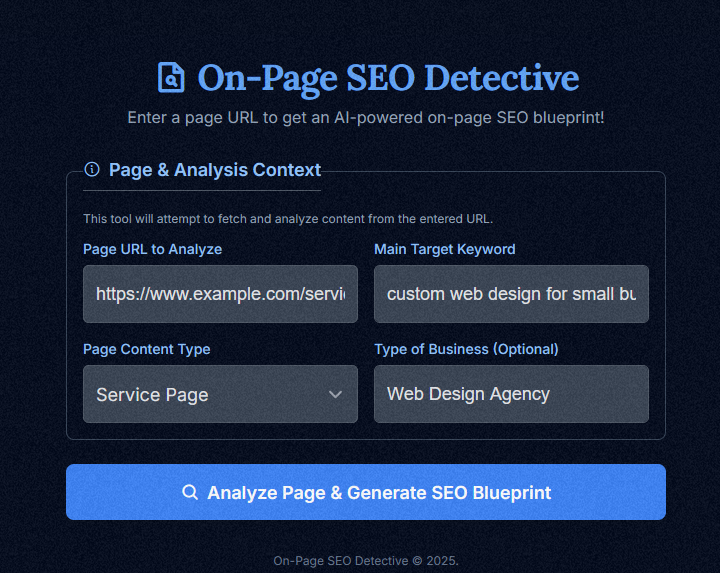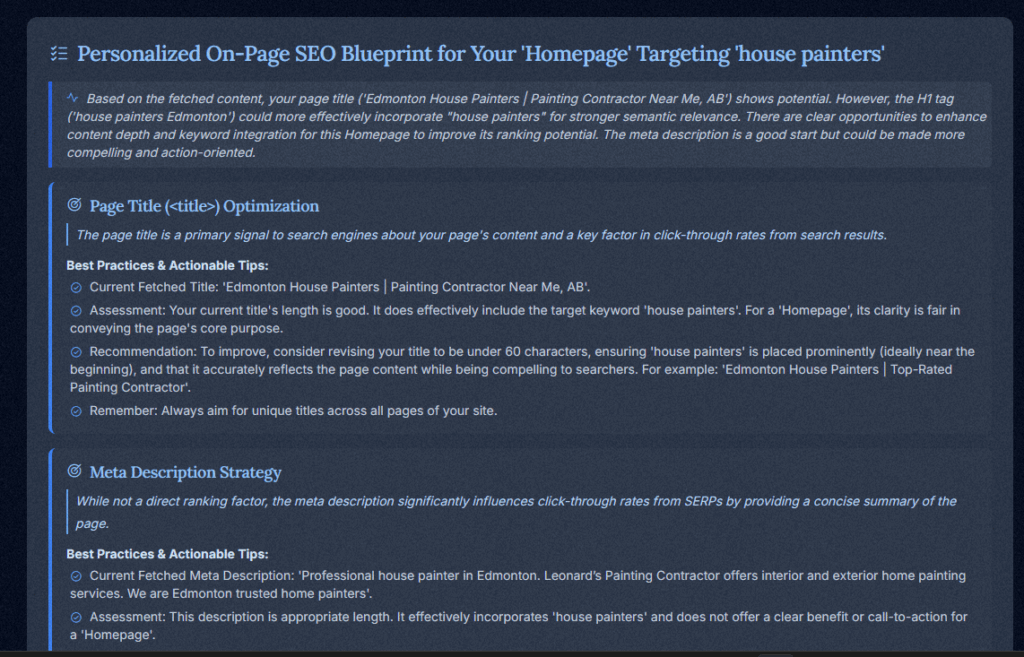On-Page SEO Detective Tool
Enter a page URL to get an AI-powered on-page SEO blueprint!
Fetching page content and analyzing...
On-Page SEO Blueprint
Top 3 Priority Actions:
Common On-Page Mistakes to Avoid:
How We Can Help:
Get On-Page SEO Assistance
Master Your Website’s Success with the On-Page SEO Detective Tool
Getting your website’s on-page optimization right is essential, but it can be tricky to know where to start. The On-Page SEO Detective Tool is designed to help. It uses AI to guide you through improving your on-page seo. Good on-page seo helps search engines understand your content and connect you with the right audience.

What is On-Page SEO? (And Why It Matters for Your Site)
To build trust, better search rankings, and improved user experience.
On-Page SEO is the process of optimizing the content and HTML source code of individual web pages so they can rank higher in search results and attract more relevant visitors.
Search engines like Google look at your pages to see how relevant they are to what people are searching for. Well-optimized pages tend to rank better.
More Relevant Traffic: By targeting specific keywords and user needs, you draw visitors who are actually looking for what you offer
Many on-page elements, like clear headings, quick load times, and useful content, make your site better for visitors.
- Solid on-page seo is a fundamental part of being found online.
Identifying Core On-Page SEO Issues with AI
The On-Page SEO Detective Tool uses AI to give you practical advice on your website’s setup. It looks at your webpage’s main on-page elements—your content, structure, and some technical aspects—to find areas that might be holding back your search engine performance. The goal is to give you clear information to help you improve your on-page seo strategy.
Key Elements Analyzed by Our On-Page SEO Tool
Our tool examines several important on-page factors:
- Keyword Use:
- Checks how well your target keywords are used.
- Looks at keyword placement to see if it feels natural, not forced.
- Suggests ways to use related terms (semantic keywords) to cover your topic more broadly. (For more on this, see our guide on [choosing effective keywords – example internal link to a blog post]).
- Title Tag Effectiveness:
- Reviews your title tags for clarity, length, and use of keywords.
- Offers advice for writing titles that are more likely to get clicked in search results.
- Meta Description Quality:
- Checks if meta descriptions are present, the right length, and clear.
- Provides tips for writing brief summaries that encourage clicks.
- Header Tag Structure (H1-H6):
- Looks at your use of H1-H6 tags to see if they create a logical outline for your content.
- Helps ensure your main topics are clear to users and search engines, which supports your on-page seo.
- Content Readability Signals:
- Gives an initial check of how easy your content is to read.
- Identifies elements that help visitors engage with your information.
- URL Structure:
- Examines your URLs to see if they are user-friendly and follow SEO best practices (e.g., short, include keywords).
- Basic Image SEO:
- Checks if your images have alt text.
- Stresses the need for descriptive alt text and sensible file names for images. (Our [Image SEO Tips guide – example internal link] has more detail).
- Internal Linking Suggestions:
- Points out places where internal links could help users find more of your content and spread link value.
- Page Load Speed Importance:
- While not a full speed test, it notes that page speed is important for users and on-page seo.
- Mobile-Friendliness Awareness:
- Acknowledges that your site needs to work well on mobile devices for good on-page seo.
- Understanding Your On-Page SEO Detective Report
Using Your Report: Practical On-Page SEO Steps

The On-Page SEO Detective Tool will give you a straightforward report. It will show you what’s working well and what specific things could be improved. Remember, the AI analysis offers strategic guidance to get you started. Use the recommendations to decide what changes will have the most impact on your on-page seo.
Practical Tips for Improving Your Website’s On-Page SEO
After you get your report:
- Start with Title Tags and Meta Descriptions: These can be quick fixes that may improve your click-through rates.
- Adjust Header Use: Make sure your H1 clearly states the page topic. Use H2s and H3s to break down content logically. If it makes sense, include variations of ‘on-page seo’ or related terms in your subheadings.
- Make Content Clearer: If the tool suggests improving readability, try using simpler words, shorter sentences, or bullet points.
- Work on Image SEO: Write descriptive alt text for all key images.
- Check Internal Links: Add relevant internal links to help users navigate and to support your SEO. (Make sure other relevant pages on your site also link to this page with appropriate anchor text like “on-page seo tool,” “website analysis for seo,” or “On-Page SEO Detective guidance”).